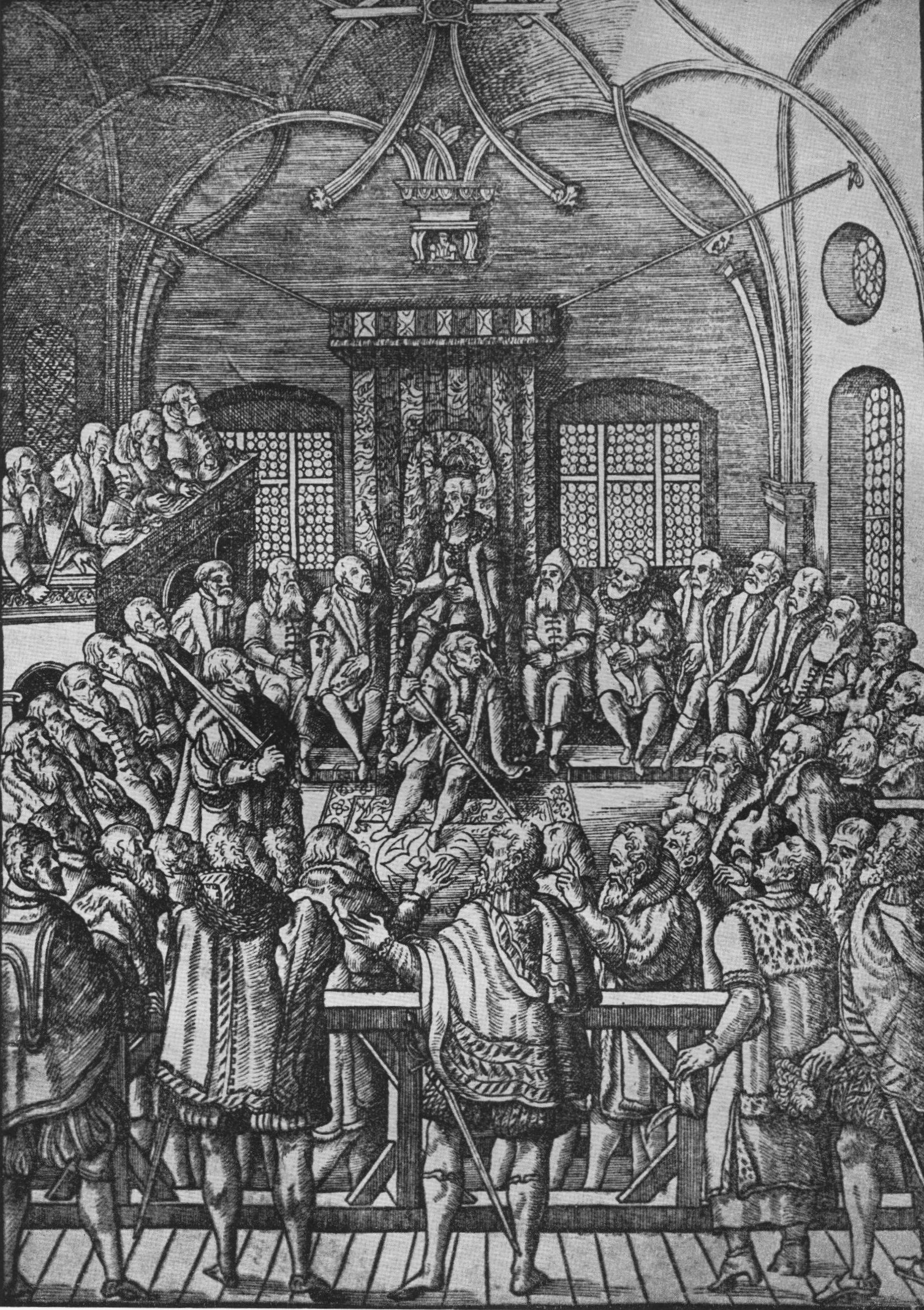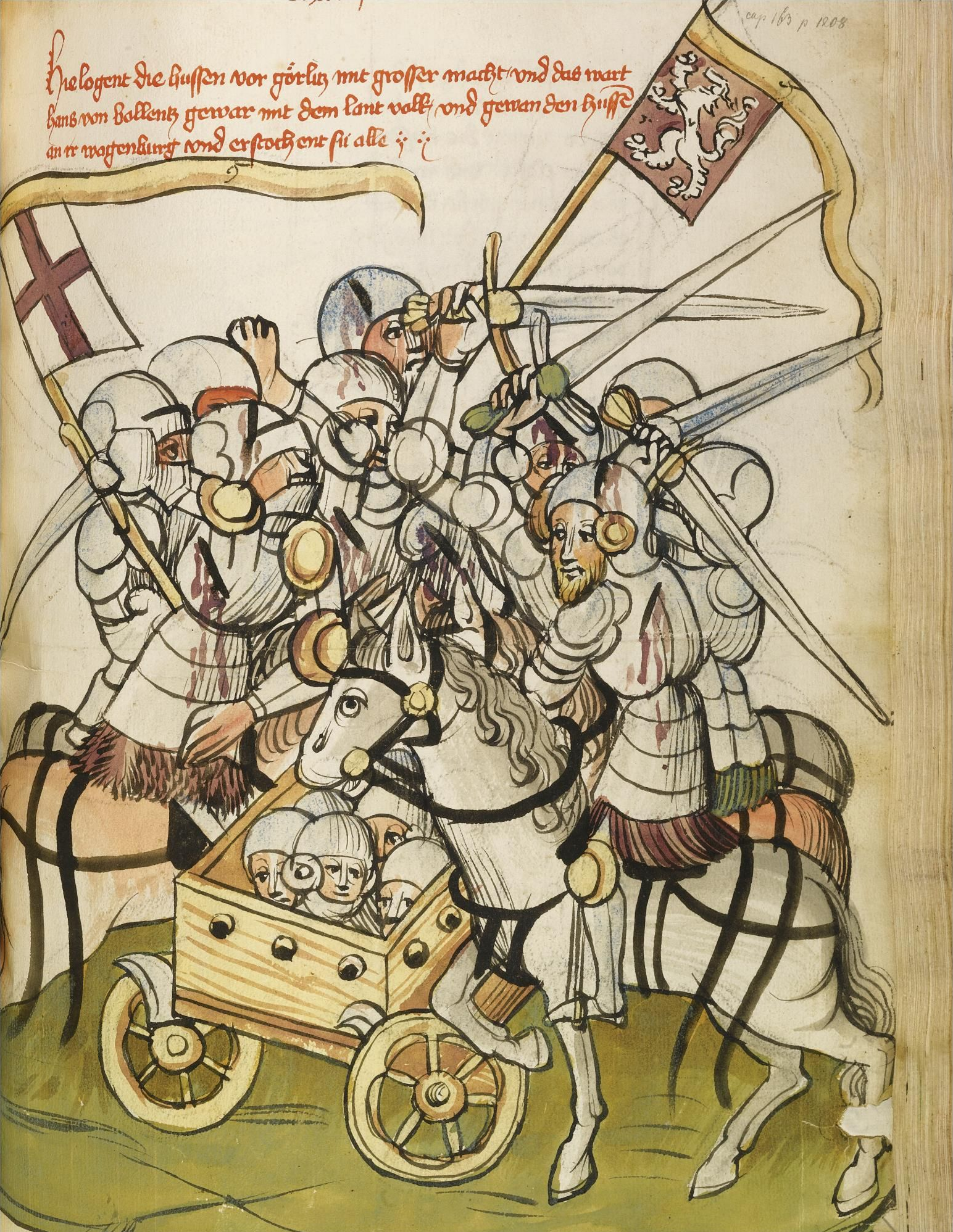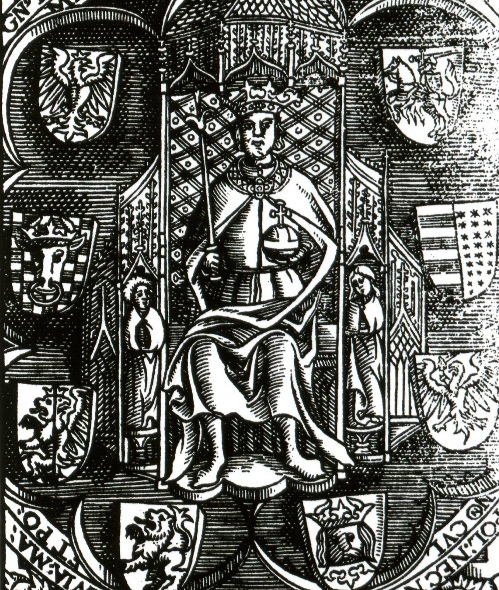|
Vladislas II Of Hungary
Vladislaus II, also known as Vladislav, Władysław or Wladislas (; 1 March 1456 – 13 March 1516), was King of Bohemia from 1471 to 1516 and King of Hungary and King of Croatia from 1490 to 1516. As the eldest son of Casimir IV Jagiellon, he was expected to inherit the Crown Kingdom of Poland and adjacent Grand Duchy of Lithuania. George of Poděbrady, the Hussite (followers of late 14th-early 15th centuries and pre-Protestant Bohemian Reformer in the Roman Catholic Church of persecuted theologian John Hus, 1370–1415) ruler of Bohemia, offered to make Vladislaus his heir in 1468. George needed Casimir's support against the rebellious Roman Catholic noblemen and their ally King of Hungary Matthias Corvinus. The Diet of Bohemia elected Vladislaus king after George's death, but he could rule only Bohemia proper because Matthias, whom the Roman Catholic nobles had elected king, occupied adjacent Moravia, and further east of Silesia in southeastern Germany and both Lusatias. Vladi ... [...More Info...] [...Related Items...] OR: [Wikipedia] [Google] [Baidu] |
King Of Bohemia
The Duchy of Bohemia was established in 870 and raised to the Kingdom of Bohemia in Golden Bull of Sicily, 1198. Several Bohemian monarchs ruled as non-hereditary kings and first gained the title in 1085. From 1004 to 1806, Bohemia was part of the Holy Roman Empire, and its ruler was an Prince-elector, elector. From 1526 to 1804, the Kingdom of Bohemia, together with the other lands of the Bohemian Crown, was ruled under a personal union as part of the Habsburg monarchy. From 1804 to 1918, Bohemia was part of the Austrian Empire, which itself was part of the dual monarchy of Austria-Hungary from Austro-Hungarian Compromise of 1867, 1867 to 1918. Following the Dissolution of Austria-Hungary, dissolution of the monarchy, the Bohemian lands, now also referred to as Czech lands, became part of Czechoslovakia, and they have formed today's Czech Republic since the 1993 dissolution of Czechoslovakia. Legendary rulers of Bohemia * Lech, Czech, and Rus', Praotec Čech (Pater Boemus) * Lech ... [...More Info...] [...Related Items...] OR: [Wikipedia] [Google] [Baidu] |
Buda
Buda (, ) is the part of Budapest, the capital city of Hungary, that lies on the western bank of the Danube. Historically, “Buda” referred only to the royal walled city on Castle Hill (), which was constructed by Béla IV between 1247 and 1249 and subsequently served as the capital of the Kingdom of Hungary from 1361 to 1873. In 1873, Buda was administratively unified with Pest, Hungary, Pest and Óbuda to form modern Budapest. Royal Buda is called the ''Castle Quarter (Budapest), Várnegyed'' () today, while “Buda” ''pars pro toto'' denotes Budapest’s I., II., III., XI., XII. and XXII. districts. This colloquial definition thus includes medieval Óbuda and amounts to a third of the city’s total area, much of it forested. Buda's landmarks include the Royal Palace (Budapest), Royal Palace, Matthias Church, the Citadella, Gellért Baths, the Buda Hills, the Carmelite Monastery of Buda, and the residence of the President of Hungary, Sándor Palace. Etymology Accord ... [...More Info...] [...Related Items...] OR: [Wikipedia] [Google] [Baidu] |
Diet Of Bohemia
The Bohemian Diet (, ) was the parliament of the Kingdom of Bohemia within the Austro-Hungarian Empire between 1861 and Czechoslovak independence in 1918. The Diet during the Absolutist Period In 1471, the Bohemian estates elected the Jagiellon Vladislav II as their king. In 1500, the Land Assembly approved the '' Vladislav Land Establishment,'' named after the king, which gave the Bohemian noblemen an extensive share in political co-decision and is also considered to be the oldest written Czech constitution. The chairman of the assembly was called the '' Supreme Burgrave'' ('','' ). He led talks with eight jurors appointed by the assembly, two from each state. After the defeat of the Bohemian estates in the Battle of White Mountain, Ferdinand II would proclaim in 1627 for Bohemia and 1628 for Moravia the '' Renewed Regional Code'', in which the monopoly position of the states was abolished in favour of the provincial government. Despite these limitations, the Diet an ... [...More Info...] [...Related Items...] OR: [Wikipedia] [Google] [Baidu] |
Catholic
The Catholic Church (), also known as the Roman Catholic Church, is the List of Christian denominations by number of members, largest Christian church, with 1.27 to 1.41 billion baptized Catholics Catholic Church by country, worldwide as of 2025. It is among the world's oldest and largest international institutions and has played a prominent role in the history and development of Western civilization.Gerald O'Collins, O'Collins, p. v (preface). The church consists of 24 Catholic particular churches and liturgical rites#Churches, ''sui iuris'' (autonomous) churches, including the Latin Church and 23 Eastern Catholic Churches, which comprise almost 3,500 dioceses and Eparchy, eparchies List of Catholic dioceses (structured view), around the world, each overseen by one or more Bishops in the Catholic Church, bishops. The pope, who is the bishop of Rome, is the Papal supremacy, chief pastor of the church. The core beliefs of Catholicism are found in the Nicene Creed. The ... [...More Info...] [...Related Items...] OR: [Wikipedia] [Google] [Baidu] |
John Hus
Jan Hus (; ; 1369 – 6 July 1415), sometimes anglicized as John Hus or John Huss, and referred to in historical texts as ''Iohannes Hus'' or ''Johannes Huss'', was a Czech theologian and philosopher who became a Church reformer and the inspiration of Hussitism, a key predecessor to Protestantism, and a seminal figure in the Bohemian Reformation. Hus is considered to be the first Church reformer, even though some designate the theorist John Wycliffe. His teachings had a strong influence, most immediately in the approval of a reformed Bohemian religious denomination and, over a century later, on Martin Luther. After being ordained as a Catholic priest, Hus began to preach in Prague. He opposed many aspects of the Catholic Church in Bohemia, such as its views on ecclesiology, simony, the Eucharist, and other theological topics. Hus was a master, dean and rector at the Charles University in Prague between 1409 and 1410. Alexander V issued a Papal bull that excommunicated Hus; h ... [...More Info...] [...Related Items...] OR: [Wikipedia] [Google] [Baidu] |
Bohemia
Bohemia ( ; ; ) is the westernmost and largest historical region of the Czech Republic. In a narrow, geographic sense, it roughly encompasses the territories of present-day Czechia that fall within the Elbe River's drainage basin, but historically it could also refer to a wider area consisting of the Lands of the Bohemian Crown ruled by the List of Bohemian monarchs, Bohemian kings, including Moravia and Czech Silesia, in which case the smaller region is referred to as Bohemia Proper as a means of distinction. Bohemia became a part of Great Moravia, and then an independent principality, which became a Kingdom of Bohemia, kingdom in the Holy Roman Empire. This subsequently became a part of the Habsburg monarchy and the Austrian Empire. After World War I and the establishment of an History of Czechoslovakia (1918–1938), independent Czechoslovak state, the whole of Bohemia became a part of Czechoslovakia, defying claims of the German-speaking inhabitants that regions with German ... [...More Info...] [...Related Items...] OR: [Wikipedia] [Google] [Baidu] |
Protestantism
Protestantism is a branch of Christianity that emphasizes Justification (theology), justification of sinners Sola fide, through faith alone, the teaching that Salvation in Christianity, salvation comes by unmerited Grace in Christianity, divine grace, the priesthood of all believers, and the Bible as the sole infallible source of authority for Christian faith and practice. The five solae, five ''solae'' summarize the basic theological beliefs of mainstream Protestantism. Protestants follow the theological tenets of the Reformation, Protestant Reformation, a movement that began in the 16th century with the goal of reforming the Catholic Church from perceived Criticism of the Catholic Church, errors, abuses, and discrepancies. The Reformation began in the Holy Roman Empire in 1517, when Martin Luther published his ''Ninety-five Theses'' as a reaction against abuses in the sale of indulgences by the Catholic Church, which purported to offer the remission of the Purgatory, temporal ... [...More Info...] [...Related Items...] OR: [Wikipedia] [Google] [Baidu] |
Hussites
upright=1.2, Battle between Hussites (left) and Crusades#Campaigns against heretics and schismatics, Catholic crusaders in the 15th century upright=1.2, The Lands of the Bohemian Crown during the Hussite Wars. The movement began during the Prague.html" ;"title="Renaissance in Prague">Renaissance in Prague and quickly spread south and then through the rest of the Kingdom of Bohemia. Eventually, it expanded into the remaining domains of the Bohemian Crown as well. The Hussites (Czech: ''Husité'' or ''Kališníci'', "Chalice People"; Latin: ''Hussitae'') were a Czech Proto-Protestantism, proto-Protestant Christian movement influenced by both the Byzantine Rite and John Wycliffe that followed the teachings of reformer Jan Hus (fl. 1401–1415), a part of the Bohemian Reformation. The Czech lands had originally been Christianized by Byzantine Greek missionaries Saints Cyril and Methodius, who introduced the Byzantine Rite in the Old Church Slavonic liturgical language and the B ... [...More Info...] [...Related Items...] OR: [Wikipedia] [Google] [Baidu] |
Grand Duchy Of Lithuania
The Grand Duchy of Lithuania was a sovereign state in northeastern Europe that existed from the 13th century, succeeding the Kingdom of Lithuania, to the late 18th century, when the territory was suppressed during the 1795 Partitions of Poland, partitions of Poland–Lithuania. The state was founded by Lithuanians (tribe), Lithuanians, who were at the time a Lithuanian mythology, polytheistic nation of several united Baltic tribes from Aukštaitija. By 1440 the grand duchy had become the largest European state, controlling an area from the Baltic Sea in the north to the Black Sea in the south. The grand duchy expanded to include large portions of the former Kievan Rus' and other neighbouring states, including what is now Belarus, Lithuania, most of Ukraine as well as parts of Latvia, Moldova, Poland and Russia. At its greatest extent, in the 15th century, it was the largest state in Europe. It was a multinational state, multi-ethnic and multiconfessionalism, multiconfessional sta ... [...More Info...] [...Related Items...] OR: [Wikipedia] [Google] [Baidu] |
Kingdom Of Poland
The Kingdom of Poland (; Latin: ''Regnum Poloniae'') was a monarchy in Central Europe during the Middle Ages, medieval period from 1025 until 1385. Background The West Slavs, West Slavic tribe of Polans (western), Polans who lived in what is today the historic region of Greater Poland, gave rise to a state in the early 10th century, which would become the nascent predecessor of the Kingdom of Poland. Following the Christianization of Poland in 966, and the emergence of the Duchy of Poland during the rule of Mieszko I, his eldest son Bolesław I the Brave inherited his father's dukedom and subsequently was crowned as king. History Establishment In 1025, Bolesław I the Brave of the Piast dynasty was crowned as the first List of Polish monarchs, King of Poland at the Gniezno Cathedral, cathedral in Gniezno and elevated the status of Poland from a duchy to a monarchy, kingdom after receiving permission for his coronation from Pope John XIX. Following the death of Boles ... [...More Info...] [...Related Items...] OR: [Wikipedia] [Google] [Baidu] |
Casimir IV Jagiellon
Casimir IV (Casimir Andrew Jagiellon; ; Lithuanian: ; 30 November 1427 – 7 June 1492) was Grand Duke of Lithuania from 1440 and King of Poland from 1447 until his death in 1492. He was one of the most active Polish-Lithuanian rulers; under him, Poland defeated the Teutonic Knights in the Thirteen Years' War and recovered Pomerania. The Jagiellonian dynasty became one of the leading royal houses in Europe. The great triumph of his reign was bringing Prussia under Polish rule. The rule of Casimir corresponded to the age of "new monarchies" in western Europe. By the 15th century, Poland had narrowed the distance separating it from Western Europe and became a significant power in international relations. The demand for raw materials and semi-finished goods stimulated trade, producing a positive balance, and contributed to the growth of crafts and mining in the entire country. He was a recipient of the English Order of the Garter (KG), the highest order of chivalry and the most ... [...More Info...] [...Related Items...] OR: [Wikipedia] [Google] [Baidu] |










